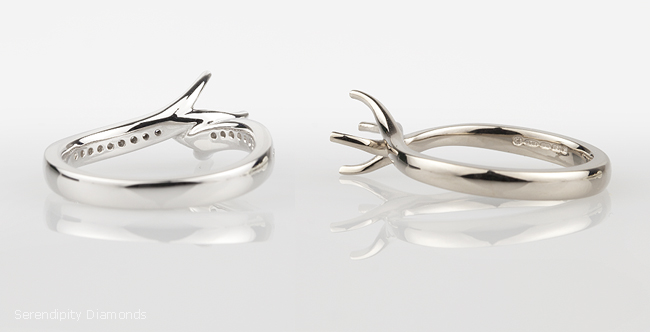18ct Gold with and without Rhodium.

Showing two twist ring mounts, prior to setting the diamond. (Left) with the Rhodium plating, (right) without. This is the true metal colour of 18ct White Gold.
What is Rhodium plating?
Most jewellery workshops apply Rhodium plating to white gold as a standard practice. This chemical element with the symbol Rh has an atomic number of 45 with a silvery-white, hard, corrosion-resistant appearance, classified as a transition metal.
The difference in colour between 18ct White Gold with and without Rhodium plating
Whether you were aware or not, 18ct White Gold is not a completely white metal. Most alloys are slightly off-white owing to the 75% concentration of Gold within the metal. Once the ring mount has been set with stones, and polished, the Rhodium Plating is applied by electrolysis. This results in a very white, coating which provides 18ct White Gold with the finished appearance. But why is Rhodium-plated 18ct White Gold so popular?
Another variation of this popular plating provides a black colour, popular in usage with black diamonds.
Why choose a Rhodium Plated engagement ring?
The following are four notes well worth noting here.
1. Rhodium forms a protective barrier. An ultra-hard outer layer of metal protecting both the ring metal itself, generally more resistant to scratches than Platinum.
2. The bright whiteness of the Rhodium complements the whiteness of the diamond.
3. The main area of wear on the ring is typically below the finger. Where a discoloured worn away area reveals itself with time, this is hardly visible. Do not mistake Rhodium wear with tarnishing, which many people do.
4. The cost to re-finish (ie. clean, polish and Rhodium plate) the ring will likely be equivalent to re-polishing a Platinum ring, and a minor cost at that.
Is Platinum better than Rhodium Plated Gold?
Platinum certainly does have its advantages. Many buyers favour Platinum due to its natural silver-grey colour. When you view a Platinum ring, you are looking at the true colour of the polished metal. Unlike 18ct White Gold, there is no plating applied to Platinum. Don’t get confused with Platinum plating, often applied to cheaper jewellery sold on auction sites. Some buyers prefer 18ct White Gold because the Rhodium plating is more scratch resistant to Platinum. Either way, both choices need occasional re-finishing depending on the extent of wear.
Rhodium facts chart
| Fact | |
|---|---|
| 1. | A rare and precious metal. |
| 2. | Has a brilliant silver-white color and is highly reflective. |
| 3. | Has a high melting point of 1,964°C (3,567°F). |
| 4. | Symbol on the periodic table is “Rh,” and it has an atomic number of 45. |
| 5. | An extremely hard and durable metal. |
| 6. | Can absorb large amounts of hydrogen gas at room temperature. |
| 7. | Widely used in catalytic converters in automobiles. |
| 8. | Highly resistant to corrosion and oxidation. |
| 9. | Used in medical applications and dental alloys. |
| 10. | One of the most expensive precious metals. |
| 11. | Rhodium is a noble metal, meaning it is resistant to chemical reactions and does not easily tarnish. |
| 12. | It is primarily mined as a byproduct of platinum and nickel mining. |
| 13. | Rhodium compounds are used as catalysts in various organic chemical reactions. |
| 14. | Its reflective properties make it suitable for use in optics, including telescopes and searchlights. |
| 15. | Rhodium plating is often used to enhance the appearance and durability of white gold jewelry. |
| 16. | It is employed in the electronics industry for coating electrical contacts to improve conductivity and prevent corrosion. |
| 17. | Rhodium has superconducting properties at very low temperatures. |
| 18. | The largest producer of rhodium is South Africa, followed by Russia and Zimbabwe. |
| 19. | Rhodium is sometimes used as a catalyst in the production of nitric acid. |
| 20. | It has antimicrobial properties and is utilized in antimicrobial coatings and medical devices. |
White gold is naturally straw-coloured, owing to the concentration of natural gold. For this reason, jewellers electroplate items with Rhodium—an ultra-white hard precious metal to create a blistering silver-white colour.
White gold is an alloy of gold, mixed with a combination of other precious and non-precious metals. The concentration of gold varies depending on the fineness or purity of the item. For example, 9-carat gold contains 37.5% gold, whilst 18-carat gold contains 75% gold.
Yes. As the Rhodium plating wears away, the natural colour of white gold appears as the natural colour of the gold is revealed. This process takes anywhere between 3 – 6 months but can be re-applied at any time.
Jewellers make white gold by melting gold and other white metals at extremely high temperature to create a blend with specific ratios, benefitting from the colour and physical properties of each alloy used.
The worth of any item at the lowest cost depends on the purity and gram weight. Bullion dealers publish scrap metal prices daily, based on the gram price of either hallmarked or non-hallmarked items. Just like the price of all precious metals, this price goes up or down depending on the current market price of gold.
White gold does not turn yellow. It merely loses its silvery Rhodium plating due to wear and reveals the natural off-white colour of the actual white gold underneath.
About Mark Johnson
My name is Mark and I'm founder at Serendipity Diamonds. I have 30 years or experience in polished diamonds and jewellery. Today, I work with an expert team in our Isle of Wight jewellery showroom located in Ryde. Most of my work involves helping clients in our showroom, working on our two websites and photographing jewellery commissions.


